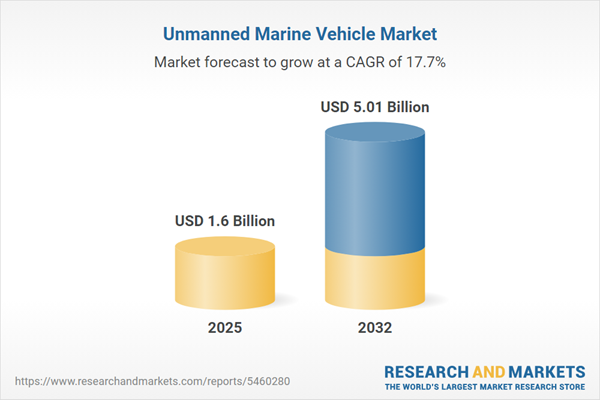Speak directly to the analyst to clarify any post sales queries you may have.
The unmanned marine vehicle market is transforming operational priorities for maritime leaders, enabling streamlined management, technology integration, and compliance improvements across both commercial and defense sectors. As organizations seek to remain ahead in maritime operations, adopting innovative unmanned solutions is increasingly central to competitive strategy.
Market Snapshot: Growth and Prospects in the Unmanned Marine Vehicle Market
The unmanned marine vehicle market is positioned for substantial expansion, with projections revealing a rise from USD 1.36 billion in 2024 to USD 1.60 billion in 2025 and a compound annual growth rate of 17.67% through 2032, culminating at USD 5.01 billion.
This acceleration is underpinned by rapid advancements in autonomous marine platforms and integrated sensor systems. Heightened automation is improving operational reliability, amplifying cost efficiency, and supporting flexible deployment across both commercial and defense applications. Enhanced technological capabilities now allow maritime organizations to meet emerging regulatory standards and drive efficiency in shipping, offshore energy, and oceanographic research under diverse and demanding conditions.Scope & Segmentation: Unmanned Marine Vehicle Market Coverage
This report delivers a comprehensive segmentation framework, supporting executive-level decision-making by clarifying core opportunities and emerging areas for investment within the unmanned marine vehicle sector. The following insights showcase how segmentation aligns with diverse operational and strategic requirements.
- Product Type: Autonomous Underwater Vehicles (AUVs) and Remotely Operated Vehicles (ROVs) both enable precise subsea mapping, inspection, and intervention—critical for missions in defense, industry, and environmental monitoring.
- Propulsion Type: Diesel Electric, Electric, and Hybrid propulsion systems contribute to sustainability initiatives, emission reductions, and the extension of mission continuity for data-centric or surveillance operations.
- Operation Mode: Autonomous and manual control modes grant unparalleled fleet flexibility, allowing adaptation to specific mission profiles as conditions evolve in marine environments.
- Application: Key use cases span aquaculture management, maritime surveillance, offshore energy operations, environmental monitoring, marine surveying, and scientific research—improving process compliance, risk management, and operational precision.
- Regional Coverage: The Americas, Europe, Middle East and Africa, and Asia-Pacific each reflect unique technology adoption patterns, infrastructure readiness, and regulatory trajectories, informing location-specific investment decisions and implementation pathways.
- Major Companies: Kongsberg Gruppen ASA, Teledyne Technologies Incorporated, L3Harris Technologies, Lockheed Martin Corporation, Northrop Grumman Corporation, Thales S.A., ECA Group SAS, Atlas Elektronik GmbH, Saab AB, and iXblue SAS are actively shaping the technological and commercial future of the unmanned marine vehicle industry.
Key Takeaways: Strategic Insights for Senior Leaders
- Artificial intelligence and sophisticated autonomous functions are empowering organizations to anticipate future mission requirements and compliance shifts.
- Keeping a close watch on evolving regulations supports the seamless execution of projects in complex international and local contexts.
- Collaboration among technology firms, research bodies, and service providers is unlocking specialized marine applications and expanding commercial access.
- Adoption of open architecture platforms and modular sensor packages helps optimize lifecycle costs, accelerating system upgrades and their deployment in existing fleets.
- Regional demands shape solution preferences: North America emphasizes system resilience, Europe and the Middle East focus on integration and policy synchronization, while Asia-Pacific champions automation and scale to meet expanding operational demands.
- Building a resilient and adaptable supply chain and capabilities for flexible production are increasingly vital for market success under volatile conditions and shifting compliance standards.
Tariff Impact: Navigating New Supply Chain Realities
Anticipated US tariffs in 2025 are prompting manufacturers in the unmanned marine vehicle market to adjust supply chains, relocate production to core regions, and pursue deeper vertical integration. The integration of modular architectures allows firms to swiftly adapt to new operational requirements and regulatory imperatives, strengthening supply security and bolstering robust risk management processes.
Methodology & Data Sources
Analysis in this report utilizes official government statistics, established industry metrics, and qualitative input from sector specialists and targeted workshops. The scenario-based approach ensures continued relevance for a rapidly evolving and segmented marine market.
Why This Report Matters
- Directs executive teams in prioritizing technology investments and forming effective partnerships, enhancing operational performance in maritime sectors.
- Bolsters organizational resilience and project sustainability, equipping leaders to navigate heightened offshore risks and regulatory changes.
- Provides actionable insights for C-level decision-makers, supporting agile strategies as the unmanned marine vehicle market evolves.
Conclusion
Senior leaders who embrace unmanned marine vehicles will enhance operational performance and modernize their organizations, positioning themselves to capitalize on innovation as marine operations advance.
Additional Product Information:
- Purchase of this report includes 1 year online access with quarterly updates.
- This report can be updated on request. Please contact our Customer Experience team using the Ask a Question widget on our website.
Table of Contents
3. Executive Summary
4. Market Overview
7. Cumulative Impact of Artificial Intelligence 2025
Companies Mentioned
The companies profiled in this Unmanned Marine Vehicle market report include:- Kongsberg Gruppen ASA
- Teledyne Technologies Incorporated
- L3Harris Technologies, Inc.
- Lockheed Martin Corporation
- Northrop Grumman Corporation
- Thales S.A.
- ECA Group SAS
- Atlas Elektronik GmbH
- Saab AB
- iXblue SAS
Table Information
| Report Attribute | Details |
|---|---|
| No. of Pages | 192 |
| Published | October 2025 |
| Forecast Period | 2025 - 2032 |
| Estimated Market Value ( USD | $ 1.6 Billion |
| Forecasted Market Value ( USD | $ 5.01 Billion |
| Compound Annual Growth Rate | 17.6% |
| Regions Covered | Global |
| No. of Companies Mentioned | 11 |









